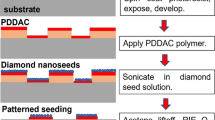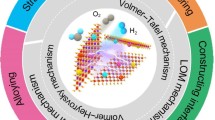Abstract
In this contribution, which is the final paper in a topic-focused series of three papers, we report on the development of experimental methodology that is applied to acquire cyclic voltammetry (CV) profiles for hemispherical Pt(111), Pt(110), and Pt(100) as well as polyoriented monocrystalline Pt electrodes. The paper describes an effective, multi-step procedure for cleaning of electrochemical and annealing glassware. The procedure comprises a four-step process for cleaning glassware and a three-step process for cleaning Viton and Teflon parts to minimize any contamination that can originate from these setup components. The contribution also outlines general laboratory practices that need to be followed in order to maintain clean conditions for conducting electrochemical experiments. The paper discusses a thermal treatment methodology that consists of two steps, namely flame-based annealing and induction-based annealing. The application of this approach produces reproducible, clean, defect-free, and atomically-ordered Pt surfaces. The complete procedure of Pt electrode annealing, cooling in a controlled atmosphere, protecting with a droplet of water, and transferring to an electrochemical cell allows one to conserve a metallic character of the electrode surface (it does not form any oxide during the transfer) while maintaining an atomic order. In addition, the paper describes the design and operation of a multi-component electrochemical workstation, which is employed in measurements on platinum electrochemistry and electrocatalysis. The paper presents and discusses the hanging meniscus configuration that is used to maintain an electrolytic contact between a monocrystalline Pt electrode and an aqueous electrolyte solution. Finally, the contribution presents CV profiles for hemispherical Pt(111), Pt(110), and Pt(100) as well as polyoriented, monocrystalline Pt electrodes, which are characteristics of high-quality electrodes and clean experimental conditions. These results validate the instrumentation described in the series of papers and the laboratory practices developed in the course of our research.

ᅟ









Similar content being viewed by others
References
N. Arulmozhi, G. Jerkiewicz, Electrocatalysis 7, 507 (2016)
N. Arulmozhi, G. Jerkiewicz, Electrocatalysis 8, 399 (2017)
A. Hamelin, in Modern aspects of electrochemistry, ed. by B. E. Conway, R. E. White, and J. O’M. Bockris, (Plenum Press, New York, 1985), p. 1
H. Angerstein-Kozlowska, in Comprehensive Treatise of Electrochemistry, ed. by R. E. White, J. O. M. Bockris, B. E. Conway. (Plenum Press, New York, 1984) ch. 9
A.T. Hubbard, Chem. Rev. 88, 633 (1988)
A.T. Hubbard, J.L. Stickney, M.P. Soriaga, V.K.F. Chia, S.D. Rosasco, B.C. Schardt, T. Solomun, D. Song, J.H. White, A. Wieckohski, J. Electroanal. Chem. 168, 43 (1984)
J. Clavilier, R. Faure, G. Guinet, R. Durand, J. Electroanal. Chem. 107, 205 (1980)
J. Clavilier, J. Electroanal. Chem. 107, 211 (1980)
D. M. Kolb, F. C. Simeone, in Scanning Tunneling Microscopy in Surface Science, ed. by M. Bowker, P. R. Davies (Wiley-VCH Verlag, Weinheim, 2010), p. 119
L. A. Kibler, Preparation and Characterization of Noble Metal Single Crystal Electrode Surfaces (International Society of Electrochemistry, 2003). https://www.uniulm.de/fileadmin/website_uni_ulm/nawi.inst.080/mitarbeiter/Kibler/KiblerSingleCrystals2003.pdf. Accessed 3 October 2017
C. Korzeniewski, V.Climent, J.M. Feliu, in Electroanalytical Chemistry: A Series of Advances, ed. by A. J. Bard, C. Zoski, Vol 24 (CRC, New York, 2011), p. 75
D. Dickertmann, F.D. Koppitz, J.W. Schultze, Electrochim. Acta 21, 967 (1976)
L.H. Dall'Antonia, G. Tremiliosi-Filho, G. Jerkiewicz, J. Electroanal. Chem. 502, 72 (2001)
G. Jerkiewicz, Electrocatalysis 1, 179 (2010)
N. Furuya, S. Koide, Surf. Sci. 220, 18 (1989)
Milli-Q® Integral Water Purification System (EMD Millipore Corporation, 2017). http://www.emdmillipore.com/CA/en/product/Milli-Q-Integral-Water-Purification-System-for-Ultrapure-Water,MM_NF-C72876. Accessed 3 October 2017
D.J.G. Ives, G.J. Janz, Reference Electrodes: Theory and Practice (Academic Press, New York, 1961)
N.M. Marković, B.N. Grgur, C.A. Lucas, P.N. Ross, Surf. Sci. 384, L805 (1997)
L.A. Kibler, A. Cuesta, M. Kleinert, D.M. Kolb, J. Electroanal. Chem. 484, 73 (2000)
G.A. Attard, K. Hunter, E. Wright, J. Sharman, R. Martínez-Hincapié, J.M. Feliu, J. Electroanal. Chem. 793, 137 (2017)
Acknowledgments
A grateful acknowledgment is made to the Catalysis Research for Polymer Electrolyte Fuel Cells (CaRPE-FC) Network, Natural Sciences and Engineering Research Council of Canada (NSERC), Canada Foundation for Innovation (CFI), and Queen’s University for their financial support. David B. Magellan (Ambrell) is acknowledged for his help in designing the induction coil and testing of our samples at the Ambrell R&D Laboratory. Georges Kopp (CanLabGlass) is acknowledged for his unique expertise and assistance in designing and manufacturing the specialized glassware. Prof. Germano Tremiliosi Filho is acknowledged for knowledge transfer concerning the flame-based final treatment. Dr. Stève Baranton is acknowledged for improving the cleaning procedure.
Author information
Authors and Affiliations
Corresponding author
Rights and permissions
About this article
Cite this article
Arulmozhi, N., Esau, D., van Drunen, J. et al. Design and Development of Instrumentations for the Preparation of Platinum Single Crystals for Electrochemistry and Electrocatalysis Research Part 3: Final Treatment, Electrochemical Measurements, and Recommended Laboratory Practices. Electrocatalysis 9, 113–123 (2018). https://doi.org/10.1007/s12678-017-0426-2
Published:
Issue Date:
DOI: https://doi.org/10.1007/s12678-017-0426-2




